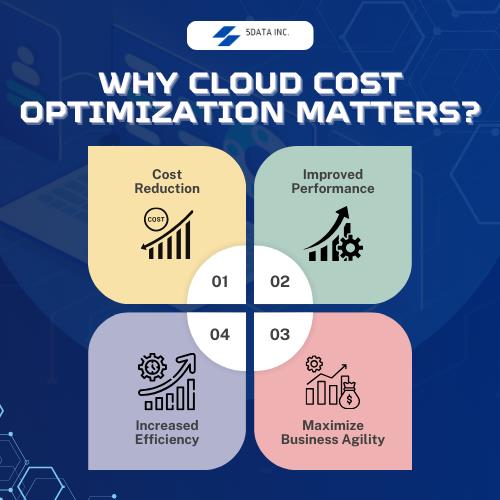What we cover in this blog
Key Takeaways
- Use cost management tools, perform regular audits, and set budget alerts to track cloud resource consumption, eliminate waste, and prevent expense surges.
- Match resources to workload demands, use tiered storage solutions for cost efficiency and leverage options like spot instances and reserved instances to minimize expenses.
- Enable auto-scaling, adopt cloud-native designs, and utilize multi-cloud or hybrid cloud strategies for flexibility, cost savings, and improved performance.
Understanding Cloud Cost Optimization
Cloud cost optimization is the practice of analyzing and adjusting cloud resource usage and spending to reduce costs while maintaining performance and reliability. It involves identifying and eliminating wasteful spending, optimizing resource utilization, and leveraging cost-saving strategies offered by cloud providers.
Why Cloud Cost Optimization Matters
- Cost Reduction: By optimizing cloud cost management, businesses can significantly reduce their IT expenses.
- Improved Performance: Rightsizing resources and optimizing configurations can enhance application performance.
- Increased Efficiency: Effective cloud management leads to more efficient use of cloud resources.
- Maximize Business Agility: Optimized cloud environments enable faster innovation and response to market changes.
Partner with a Hybrid Cloud Development company to seamlessly integrate on-premises and cloud spaces, ensuring scalability, security, and optimized performance.
5 Key Strategies to Optimize Cloud Costs and Performance
1. Monitor and Manage Cloud Resources Effectively
The first step to optimizing costs in the various cloud service provider ecosystems is to understand your cloud cost management resource usage clearly. With the large variety of services offered by cloud service providers, it’s easy to overprovision or leave idle resources, leading to unnecessary expenses.
- Leverage Cost Control Tools: Platforms such as AWS Cost Explorer, Azure Cost Management, and Google Cloud Billing help track expenditure trends and resource allocation and identify savings potential.
- Identify and Eliminate Unused Cloud Assets: Conduct regular audits to locate unused resources, such as idle virtual machines or abandoned storage volumes, and terminate them promptly.
- Set Budget Alerts: Cloud service providers allow businesses to set budget thresholds and receive alerts to prevent sudden expense surges.
By actively monitoring cloud cost management usage, businesses can maintain a lean and efficient cloud optimization architecture.

2. Rightsize Cloud Infrastructure and Optimize Resource Allocation
Rightsizing involves matching computing resources to the specific demands of your workloads. Overprovisioning resources not only inflates the cloud costs but also leads to inefficient utilization of unused assets.- Analyze Workload Requirements: Use tools to assess the performance needs of mission-critical workloads and allocate just enough resources to meet those requirements.
- Use Spot Instances for Cost Reduction: Spot instances, offered by cloud vendors like AWS, allow you to purchase unused computing capacity at discounted rates. These are ideal for non-critical workloads.
- Leverage Reserved Instances: For predictable workloads, reserved instances can lower costs by up to 75% compared to on-demand pricing.
3. Optimize Data Flow and Storage Costs
Data transmission costs and storage charges can significantly contribute to cloud spending, often going unnoticed until the cloud bill arrives. Proactively managing these aspects can result in significant cost efficiency.- Minimize Data Transmission costs: Consolidate workloads within the same region or availability zone to reduce data transfer between regions. Optimize data movement routes using content delivery networks (CDNs) when applicable.
- Adopt Tiered Storage Solutions: For archival and infrequently accessed data, use cost-effective storage solutions like Amazon S3 Glacier or Azure Cool Blob Storage.
- Automate Data Lifecycle Policies: Implement policies to move data to lower-cost storage tiers or delete unnecessary data after a set period.
4. Implement Multiple Cloud and Hybrid Strategies
Adopting a multiple cloud or hybrid cloud strategy allows businesses to avoid vendor lock-in and spend money on cloud optimization across multiple cloud vendors. This approach also enhances flexibility and performance.- Distribute Workloads Across Providers: Analyze pricing models from different cloud service providers and allocate workloads to the most cost-effective platforms.
- Utilize Multiple Cloud providers: Spreading workloads across multiple vendors not only minimizes costs but also mitigates risks of downtime due to dependency on a single cloud provider.
- Leverage Hybrid Cloud Solutions: Integrating on-premises infrastructure with the cloud provides cost savings for specific workloads while maintaining control over sensitive data.
5. Automate and Optimize with Cloud-Native Design
Automation and cloud-native design are critical for managing costs effectively in complex cloud spaces. They reduce the risk of human error and enable dynamic scaling of multiple clouds together.- Enable Auto-Scaling: Cloud-native tools can automatically scale resources higher or lower based on real-time demand, ensuring efficient resource utilization without manual intervention.
- Adopt Cloud Financial Management Practices: Incorporate financial management tools to monitor costs across budget centers, detect anomalies, and predict future spending.
- Design with Cloud-Native Principles: Applications built with microservices, containers, and serverless architectures better use computing resources and reduce waste.
Conclusion
Cloud cost Optimization and performance in cloud data platforms require a strategic approach. By monitoring resource assets, rightsizing infrastructure, managing storage costs, adopting multi-cloud strategies, and automating processes, businesses can unlock significant cost savings while maximizing the value of their cloud component investments. Implementing these strategies ensures financial efficiency and strengthens the foundation for scalable and sustainable cloud operations. Begin your cloud cost optimization journey today to transform your cloud investments into tangible business value.Frequently Asked Questions
1. What are the common causes of unused cloud solutions?
Unused Cloud resources often arise from unutilized resources, overprovisioned instances, and idle virtual machines. Regular audits and automated policies can help mitigate waste.2. How can I avoid surprise spending spikes in the cloud?
Set cloud budget alerts, use expense management tools, and monitor data exchange fees. Automation and regular reviews of cost patterns also help control costs.3. How do you manage costs in cloud systems?
Managing costs in cloud systems involves optimizing resource usage, leveraging cost management tools, and monitoring spending patterns to avoid waste and ensure efficiency.
Rasmita Patro
Author
